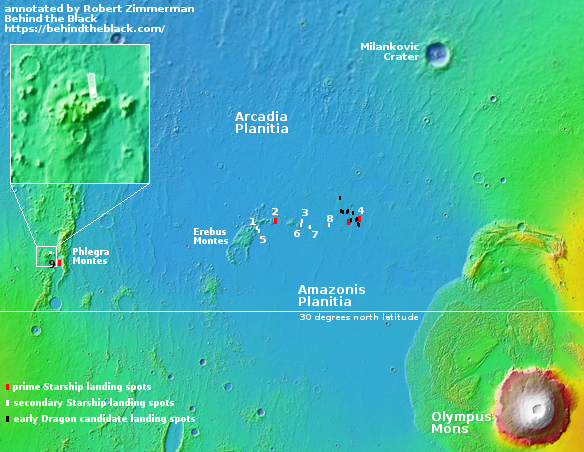No, that is not a sunspot on Mars!
Cool image time! The picture to the right, cropped to post here, was taken on April 20, 2023 by the high resolution camera on Mars Reconnaissance Orbiter (MRO). While at first glance this Martian terrain vaguely resembles the granular surface of the Sun, with the largest depression having its own faint resemblance to a sunspot, the resemblance exists only in our feverish imagination.
The depression might have been formed by an impact, though it is also possible it is a caldera, not of lava but of ice processes. The granular surface is likely resulting from the sublimation of ice, creating random holes and ridges as underground material changes from ice to gas and escapes at weak points on the surface.
My guess that we are looking at ice processes is based on the location, not far from where the first manned spacecraft will likely land.

The white dot in the inset on the overview map to the right marks the location of these features, in the Phelgra Mountains and only about fifty miles northwest from one of the four sites (#9) that, at SpaceX’s request, scientists have indicated would make good prime landing sites for Starship. Like today’s cool image, site #9 sits on an apron of material that appears to be flowing down from a mountain.
That apron is almost certainly a evidence of underground ice, especially because orbital data in this region suggests lots of near surface ice, with one scientist during a science presentation at a conference stating, “I think you could dig anywhere to get your water ice.”
On Christmas Eve 1968 three Americans became the first humans to visit another world. What they did to celebrate was unexpected and profound, and will be remembered throughout all human history. Genesis: the Story of Apollo 8, Robert Zimmerman's classic history of humanity's first journey to another world, tells that story, and it is now available as both an ebook and an audiobook, both with a foreword by Valerie Anders and a new introduction by Robert Zimmerman.
The print edition can be purchased at Amazon or from any other book seller. If you want an autographed copy the price is $60 for the hardback and $45 for the paperback, plus $8 shipping for each. Go here for purchasing details. The ebook is available everywhere for $5.99 (before discount) at amazon, or direct from my ebook publisher, ebookit. If you buy it from ebookit you don't support the big tech companies and the author gets a bigger cut much sooner.
The audiobook is also available at all these vendors, and is also free with a 30-day trial membership to Audible.
"Not simply about one mission, [Genesis] is also the history of America's quest for the moon... Zimmerman has done a masterful job of tying disparate events together into a solid account of one of America's greatest human triumphs."--San Antonio Express-News
Cool image time! The picture to the right, cropped to post here, was taken on April 20, 2023 by the high resolution camera on Mars Reconnaissance Orbiter (MRO). While at first glance this Martian terrain vaguely resembles the granular surface of the Sun, with the largest depression having its own faint resemblance to a sunspot, the resemblance exists only in our feverish imagination.
The depression might have been formed by an impact, though it is also possible it is a caldera, not of lava but of ice processes. The granular surface is likely resulting from the sublimation of ice, creating random holes and ridges as underground material changes from ice to gas and escapes at weak points on the surface.
My guess that we are looking at ice processes is based on the location, not far from where the first manned spacecraft will likely land.

The white dot in the inset on the overview map to the right marks the location of these features, in the Phelgra Mountains and only about fifty miles northwest from one of the four sites (#9) that, at SpaceX’s request, scientists have indicated would make good prime landing sites for Starship. Like today’s cool image, site #9 sits on an apron of material that appears to be flowing down from a mountain.
That apron is almost certainly a evidence of underground ice, especially because orbital data in this region suggests lots of near surface ice, with one scientist during a science presentation at a conference stating, “I think you could dig anywhere to get your water ice.”
On Christmas Eve 1968 three Americans became the first humans to visit another world. What they did to celebrate was unexpected and profound, and will be remembered throughout all human history. Genesis: the Story of Apollo 8, Robert Zimmerman's classic history of humanity's first journey to another world, tells that story, and it is now available as both an ebook and an audiobook, both with a foreword by Valerie Anders and a new introduction by Robert Zimmerman.
The print edition can be purchased at Amazon or from any other book seller. If you want an autographed copy the price is $60 for the hardback and $45 for the paperback, plus $8 shipping for each. Go here for purchasing details. The ebook is available everywhere for $5.99 (before discount) at amazon, or direct from my ebook publisher, ebookit. If you buy it from ebookit you don't support the big tech companies and the author gets a bigger cut much sooner.
The audiobook is also available at all these vendors, and is also free with a 30-day trial membership to Audible.
"Not simply about one mission, [Genesis] is also the history of America's quest for the moon... Zimmerman has done a masterful job of tying disparate events together into a solid account of one of America's greatest human triumphs."--San Antonio Express-News


